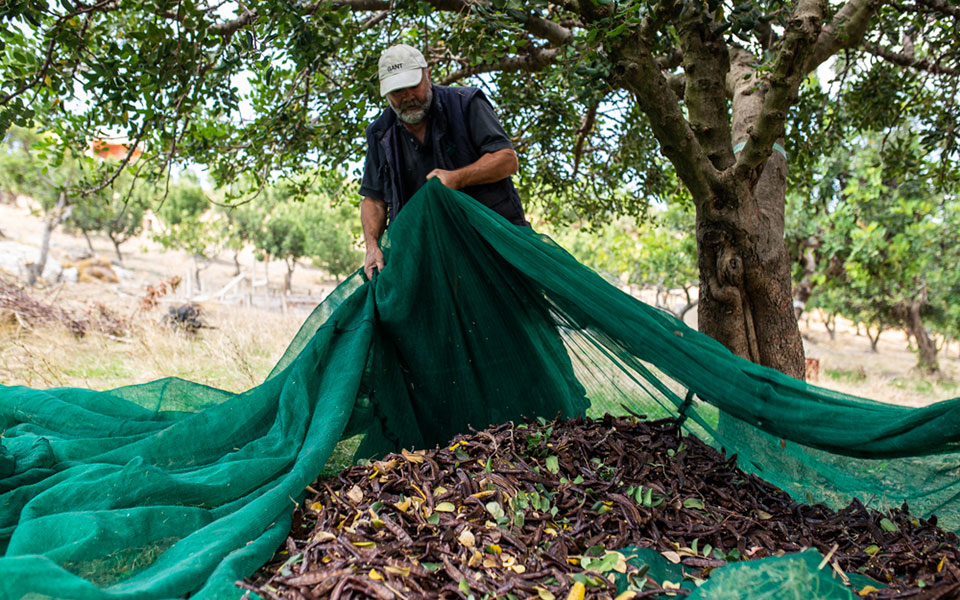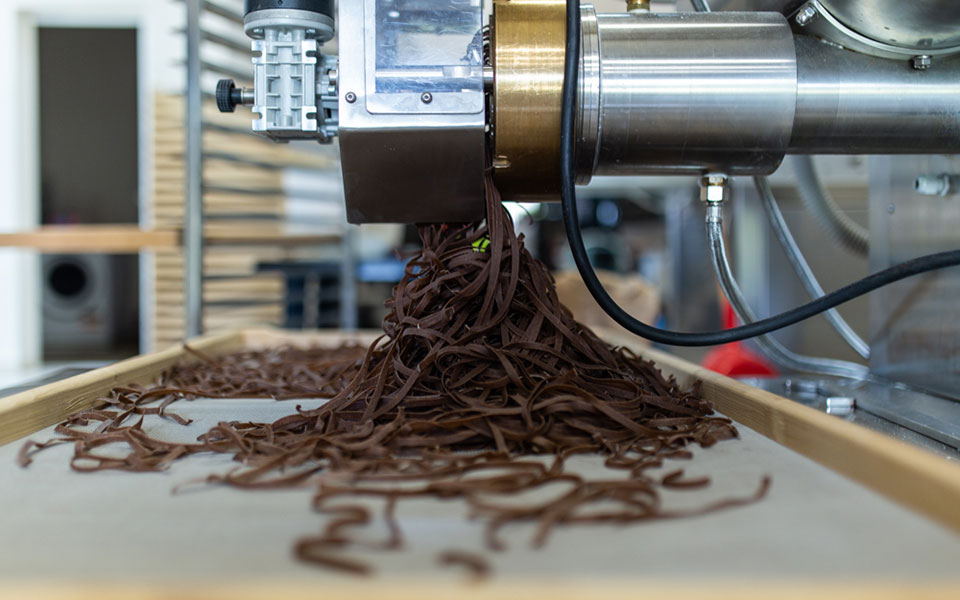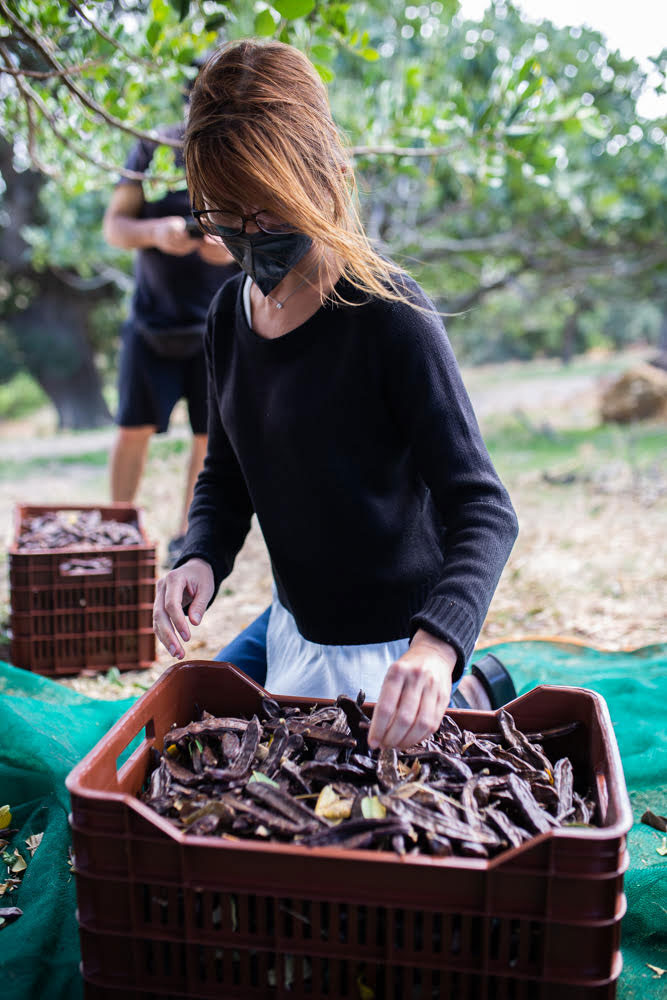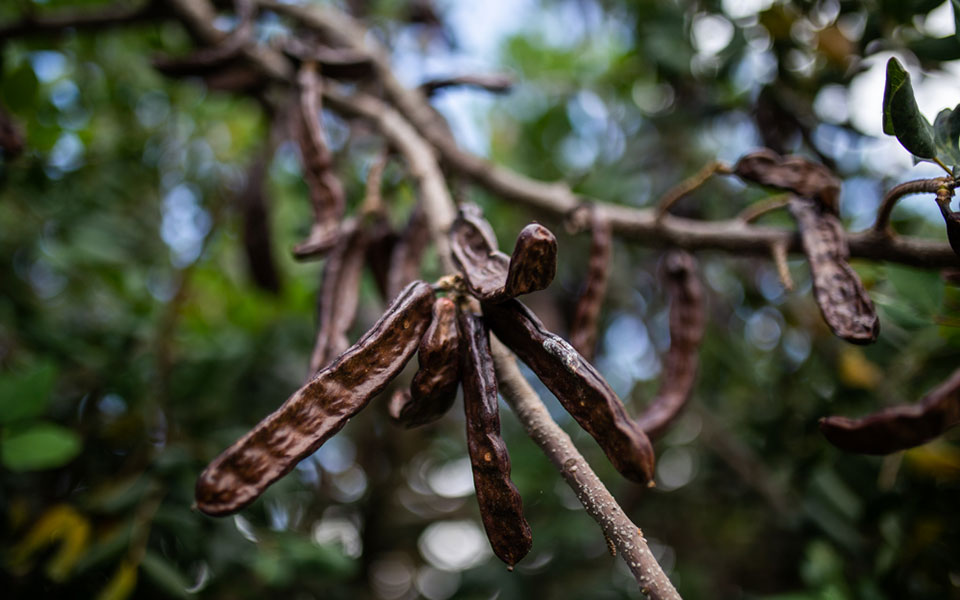
Kostas Karatsis uses a rod and gently taps the branches of the tree so that its horn-shaped pods fall into the net that he spreads below. This work requires special attention, because the flowering that the next year’s carob tree will give has already begun and the inflorescences cannot be injured. After two or three hours of weaving, the net is filled with almost 100 kilograms of carob. Mr. Karatsis owns carob plantations around Melidochori in Heraklion Prefecture, where he produces carob honey as part of his home business.

As we walk among the carob trees growing on the dry, steep slopes, he explains to me that two key characteristics of the carob tree are its exceptional drought tolerance and ability to protect soil from erosion. This is why many scientists now see this particular tree as a fire retardant as well as a response to climate change conditions. Carob does not require much maintenance, but rewards the gardener generously when harvest time comes. The collection of carob, depending on the type of tree and the microclimate of each region, begins in mid-August and ends at the end of September.
In recent years, there has been a steady increase in sales of carob-based products. The value of fruit has tripled since 2019, and this year’s harvest broke a twenty-year record. Crete is the main production area in Greece, with several dozen cultivators-processors handling it in all four prefectures of the island.
Locust genetic code
George Gavalas, an agronomist who collaborates with the Hellenic Mediterranean University and records data on the performance and characteristics of each tree, is also present during the harvest. In addition, important research projects are currently underway that study the characteristics and behavior of the Cretan carob tree. The most revealing among them is the genome study undertaken by the University of Crete and the head of the Department of Biology, Kritonas Kalantidis. This is the first analysis of the carob genome carried out worldwide, and since the necessary technology is not available in Greece, the university is collaborating with Dutch institutions.
This study is being carried out to protect the DNA of carob varieties native to Crete. Thus, once the genetic code corresponding to a particular variety is registered, no other country in the future will be able to present as its own a carob tree of Cretan origin that could be transplanted there. If we look at the added value that diversity brings to some products, such as Assyrtiko on the vine or Koroneiki on olives, the importance of this comparison becomes clearer. The first announcements of the research results will be made at the Carob Symposium, which will take place on October 9 at the old carob mill in Panormos, Rethymno. Research by the University of Crete on the chemical imprint of the carob tree is also ongoing.
Honey, pasta, nuts
One of the main reasons for the increase in demand for carob products in recent years is their high nutritional value. Carob contains three times more calcium than milk and is rich in protein, vitamins and minerals. These ingredients are preserved in carob honey, which Mr. Karatsis produces by following a method of extracting carob pods in cold water for three to four days. This process is completed by boiling at a low temperature so that the water evaporates and only carob “honey” remains in the stainless steel cauldron. Costas experimented with several varieties of carob until he chose the most palatable one. Own carob honey, which can be eaten raw or added to recipes as a sweetener, is available on the local market but is also exported to European countries.

Carob-based pasta is no less popular. Aspasia Giakumaki owns a traditional Maggiri pasta workshop in Kampos Agios Sillas, a few kilometers from Heraklion city, and specializes in the production of Cretan carob noodles. He is also experimenting with other pastas made with local ingredients and is seeing increased demand, especially from younger consumers who are looking for foods with a high nutritional value. However, the company that has spearheaded the promotion of carob products in the Greek market is Creta Carob, founded in 2008 in Argyroupoli, Rethymnon after the return of Ilias Manousakas from Canada. In addition to carob, biscuits, carob honey and carob, the company now exports several more codes to 35 countries, including Korea and Japan. Among the novelties of Creta Carob are products that combine carob flour with prickly pear flour, a product that also has a high nutritional value. However, the main problem that Mr. Manousakas highlights in the market is the unfair competition of carob imported from Turkey.

New producers and prospects for agritourism
With the growth of the purchase price of the carob tree, the interest of young people in its cultivation also increases. This is confirmed by Corina Miliaraki, president of the Epimenidis Cultural Society, which was founded to promote the carob. The company is headquartered in Panormo Rethymnon, where an old carob mill that produced carob flour and animal feed until 1966 has been restored and functions as a contemporary art and culture space. The original machines built in the 1930s are still preserved inside and are due to be put into demonstration service next month with the support of the Ministry of Culture. The company’s initiatives include the Carob of Crete platform (carobofcrete.gr) with information and videos on the history and nutritional value of carob. In fact, at the initiative of Epimenides, the agro-food tradition of the carob tree of Crete was included in the list of intangible cultural heritage, and appropriate steps are currently being taken to include it in the international list of UNESCO.
Ms Miliaraki considers the carob tree a “misunderstood” product, since only its seeds have been exported in recent decades, while the rest of the fruit has been used as animal feed. However, it was this food that saved Crete from starvation during World War II, as German soldiers did not give preference to it. Perhaps its association with famine and war conditions caused consumers to devalue it when they had more options again. Today, however, it is once again coming to the fore thanks to the recognition of its high nutritional value. There are many new growers who are interested in carob and look to Epimenides for advice on parameters that can make production more efficient. The climatic conditions in Crete are ideal for the growth of the carob tree, although there are also native trees, mostly on dry and rocky lands near the sea. Crete also has the largest natural carob forest in Europe, which is located in the Asterousia mountains of Heraklion, near the Three Churches.
Ms. Miliaraki believes that this carob forest can become an agritourism pole and combine with inland Crete trails and visits to carob processors to create a 30-acre carob park to visit. acres in the municipality of Mylopotamos. Everything shows that the Cretan carob tree is dynamically coming back to the fore and that its nutritional value and drought tolerance give it a significant competitive advantage.
The Epimenidis Cultural Society is organizing the 2022 Carob Symposium on October 9th at the Carob Factory in Panormos, Rethymnon, with the aim of promoting and raising public awareness of the carob. At the event, the University of Crete will make important scientific announcements on the study of the carob genome, the old equipment of the carob plant will be put back into operation, producers will host guests and chefs will create dishes based on carob. .
Source: Kathimerini
James Springer is a renowned author and opinion writer, known for his bold and thought-provoking articles on a wide range of topics. He currently works as a writer at 247 news reel, where he uses his unique voice and sharp wit to offer fresh perspectives on current events. His articles are widely read and shared and has earned him a reputation as a talented and insightful writer.
